TL;DR: My list of best practices for faculty in higher education teaching with social media. |

Likely other institutions are having the same conversation: what do we do about social media use within the college and their reflection on the college?
I found myself as the only full-time faculty member (!) on an ad hoc committee this summer discussing this very thing. This “Social Media Committee” discussed and drafted a policy concerning its use among “employees” of the college — i.e., its faculty and staff. Being who I am, I was hesitant to write any official policy[1] about social media because, well — does the university community really need another new policy?
Instead, my recommendation was a set of guidelines for best practices that would speak to the administration’s concerns about college representatives using social media and how that use reflected on the college. Indeed, this whole thing started by some questionable cat dissection videos being posted where they didn’t belong. This was likely an honest mistake, yet these mistakes need to be avoided in the future. Dissecting cats is appropriate, just not on the college’s marketing YouTube channel. How we can avoid these mistakes seemed to be the committee’s purview.
In our last meeting, the Provost was in attendance, and I made my suggestion about best practices. She seemed to like this idea, so I present my current top ten practices for higher ed faculty using social media.[2] I’ve put these in order of importance, and — who knows — they might change tomorrow. Here goes.
1: Participate
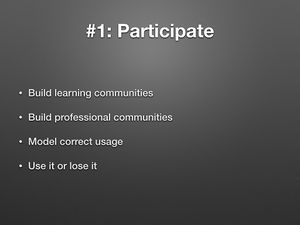
Social media allow us to participate in building personal and professional networks. They encourage individual contributions to help grow the understanding of a community and allow the community to help the individual grow. Through consistent contributions, individuals build stronger connections, affinity, and knowledge. When you participate on social media, you teach and learn. In 1959, Norman Mailer published Advertisements for Myself, in which he chose fragments from his work to construct a public personality — one that would define him for at least the next decade. While far from inventing social media, Mailer had the right idea. By participating in social media, users may construct the experts they wish to be. Only by regular participation does this happen. Social media is good for personal and professional development.
That said, this post is about teaching and learning. Consider how you use social media. If we want our students to use social media and become fluent themselves, we need to be exemplars of its use. Your practices should be a model for your students, and they will imitate you. If you are sloppy, they will adopt that practice. If you don’t seem serious, they will fool around too. I know it’s a cliché, but lead by example.
Finally, nothing is more lame than an unused social media account. If your account remains untouched — like that dusty old MySpace one — it might be better just to delete it.
2: Encourage
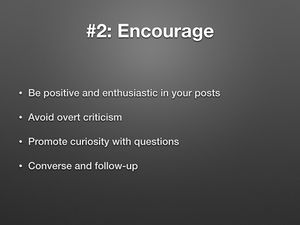
When giving feedback and advice, try to encourage and motivate students to seek their own answers and build their own understanding with positive language and questions that promote curiosity. Remember that interactions on social media are public and that you represent yourself as a professional, your institution, and the profession. Try to be positive in your contributions, especially when communicating with students and colleagues. Avoid overt criticism, negativity, and contention. Begin replies with something the student did well, then encourage her to consider areas where her work was lacking by asking her to follow up: “I wonder if you might find another article to support your reading of The Naked and the Dead?” You can be challenging as long as your attitude encourages learning, not frustration.
3: Respond
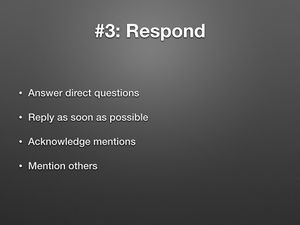
Always respond to direct questions and references in social media streams. Do so in a timely way. Perhaps one negative characteristic of teaching with social media in the age of push notifications is that they can promote impatience. Students often will expect immediate responses and become anxious when they have to wait more than a few minutes. Try to be on top of your account, and always respond as soon as possible. That said, if you like your weekends away from student contact, be sure you let them know; otherwise they might expect responses 24/7.
If someone mentions you in a tweet, take ten seconds and acknowledge it. Positive and timely responses produce good will and animate the community.
4: Choose
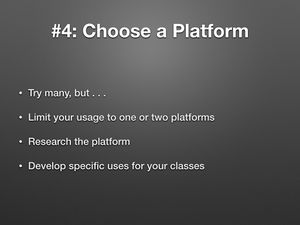
Choose the best platform for your intended use. I usually try all new services and platforms that come out. I like to be on the bleeding edge of tech trends, so when I hear about this new social media app or that new social media service, I’m usually one of the first to sign up. However, just because you sign up for a service does not compel you to include it on your syllabus. Limit your social media to one or two services. Currently, I like Twitter and Google+, but I might decide to use Tumblr next semester, and give up G+. The fewer social media you use, the better you are able to keep up with them, and the more adept your students will become using them. Trying to do too much can often lead to frustration and anxiety for you and your students.
5: Separate
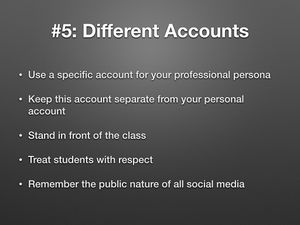
One concern of administration about social media is how users might present themselves and the university in their posts. You wouldn’t wear your beach attire to work, so you might consider having different accounts on your social media of choice: a personal one (for your weekend attire) and a professional one (for your Oxford and khakis). This way, when you use the latter, you can treat posts as if you’re standing in front of a class, choosing your words carefully and deliberately. Also, if you refer students to your professional accounts, they likely will leave your personal one alone, so you may pursue your weekend spelunking hobby in peace.
This one might be obvious, but it’s germane here: always treat students with respect, even if they don’t reciprocate. Remember, you are a professional and should comport yourself as such. Your professional behavior is even more important in social media posts, as they are public venues.
6: Be Deliberate
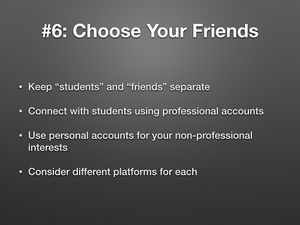
Make deliberate choices about who you “friend” and “follow.” While we are all likely friendly with our students, we should exclude them as social media friends, especially if you use specific accounts or services for personal activities. Many have asked me if I “friend” students on Facebook. I sometimes will after they graduate, but I find that keeping “students” and “friends” as separate and distinct social media connections is a cleaner and safer practice — as is keeping “family” and “friends” separate, but that’s another blog post. Use that personal account for the occasional rant about the jerk in the F-150 who cut you off on the way home or the photographic account of your most recent dining experience. Your students and colleagues don’t need to see those things. (Does anyone, really?)
7: State Your Opinions

Social media is about opinions, so you might state that explicitly. I’ve been seeing this more often on many of my Twitter connections’ profiles: “Opinions expressed are my own and do not reflect those of my employer,” or something similar. While I do not do this myself, I see nothing wrong with an explicit statement like this on social media accounts used for professional purposes. It may be insufficient legal protection, but at least it’s a nod to accountability and liability. It also shows you’re thinking about these things, and that you care about public perceptions of you and your university.
8: Respect the Law
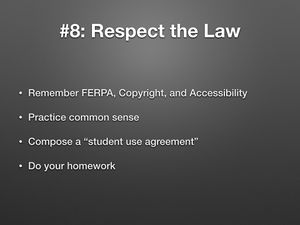
Respect the law when using social media. While the jury may still be out on how FERPA relates to social media, most educators see social media as safe to use in teaching[3] (see Orlando, Pierson, and Pacansky-Brock for lengthier insights). They seem to suggest that while social media does not violate student privacy, educators using these services need to practice common sense about what gets posted. Basically, stay away from grades, medical information, and other personal data. These educators also suggest developing a student use agreement that explicitly outlines that student posts will be public and exactly what they should avoid posting. Here’s my statement on my Twitter assignment:
As with anything done online, be aware that what you contribute to Twitter is public. Avoid discussions about aspects of your life that you wish to remain private. Be particularly cognizant about tweeting any information that should remain private, like numbers and addresses.
Never require students to release personal information on social media accounts used for class. I give students the option of using aliases, if they have concerns. Many social media sites have privacy settings that can be tweaked; do that, if appropriate.
Likewise, “fair use” of copyrighted materials remains nebulous in the digital age, especially when social media is concerned.[4] In addition, assignments that require social media for class projects should also be aware of the many discussions and documents devoted to this.[5] Head spinning yet? Common sense must prevail: keep copyrighted materials off social media sites — at least until someone works out a way to promote amateur or remix culture legally in the digital age.[6] I will not hold my breath.
Handicap accessibility must also be considered in any classroom use of social media. This can be a challenge even in the classroom. While social media sites themselves still may have hurtles to jump,[7] we educators producing our own media have many ways of making our content accessible. For example, see John Haydon’s suggestions for improving accessibility.[8]
9: Experiment
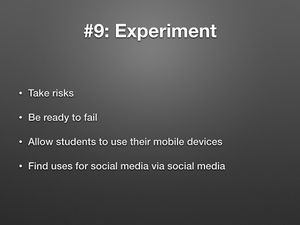
Social media encourages us to experiment. Embrace this opportunity and take some risks. Your students will support your efforts. I find that when I ask my students to take out their cell phones at the start of class, they light up, ready to try something other than the same-old. Some experiments will not work, but all will be learning experiences — if not for your students, then at least for you as an educator.
Always have a clear idea of what you hope to accomplish with your classroom use of social media. Andrew Marcinek suggests that we examine our motives: is my use of social media about promoting myself as an influencer, or is it about educating my students?[9] Having some clear goals and how you intend to accomplish them will make your social media experiments more fruitful.
If you’re looking for ideas, start following the wonderful group of tech-savvy educators on Twitter for suggestions, or read an article or two on Edudemic. There are more ideas out there than you could use in the next two years of teaching. I even have a couple for students using Twitter. Need some inspiration? Check out some videos, especially this one from Sugata Mitra.
10: Breathe

Remember to breathe. A colleague of mine in graduate school used to say about teaching with technology: always have a Plan B. Good advice. When things go wrong — and they will go wrong — just breathe and go with it. Avoid freaking out, frustration, attitude, or reticence. Social media refocuses our teaching — it demands more of our time and attention. If we keep Zen, take frequent breaks, follow the above suggestions, and breathe, our students might be the better for it. Some days will be more frustrating than others, but my teaching experiences using social media have all worked out for the best — at least in the end. Just remember to breathe.
That’s my current list. What did I miss? Let me know above in a tweet (#EdSocMedia). Next, if you enjoyed this article, you might have a look at: “Energize Teaching with Social Media.”
notes
- ↑ There is already a faculty social media policy in place, anyway, which essentially states that faculty use them in a “responsible manner, respecting the public trust through which these resources have been provided, the rights and privacy of others, the integrity of facilities and controls, state and Federal laws, and [college] policies and standards.”
- ↑ While these are specifically about faculty, several might also apply to staff members.
- ↑ For more, see: Orlando, John (February 7, 2011). "FERPA and Social Media". Faculty Focus. Retrieved 2019-06-30. Pierson, April (August 1, 2011). "Social Media & FERPA". April Pierson. Retrieved 2019-06-30. Pacansky-Brock, Michelle (May 12, 2011). "Does Social Media Violate Student Privacy?". GET Ideas. Archived from the original on May 9, 2013. Retrieved 2011-09-20.
- ↑ Wymore, Mary Ann L. (August 14, 2012). "Social Media and Fair Use: Pinterest as a Case Study". Bloomberg BMA. Archived from the original on August 12, 2014. Retrieved 2019-06-30.
- ↑ "Fair Use Codes & Best Practices". Center for Social Media. School of Communication: American University. 2013. Archived from the original on 2013-01-19. Retrieved 2019-06-30.
- ↑ See: Lessig, Lawrence (March 2007). Laws that Choke Creativity (Speech). TED2007. TED. Retrieved 2019-06-30.
- ↑ Perlman, Ellen (October 2009). "Social Media Sites' Handicap Hurdle". Governing. Retrieved 2019-06-30.
- ↑ Haydon, John (January 23, 2010). "How to make social media 'wheelchair accessible'". Socialbrite. Retrieved 2019-06-30.
- ↑ Marcinek, Andrew (October 19, 2010). "How to Help Students Use Social Media Effectively". Edutopia. George Lucas Educational Foundation. Retrieved 2019-06-30.
